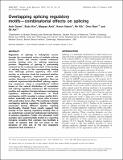| dc.contributor.author | Goren, Amir | |
| dc.contributor.author | Kim, Eddo | |
| dc.contributor.author | Amit, Maayan | |
| dc.contributor.author | Vaknin, Keren | |
| dc.contributor.author | Kfir, Nir | |
| dc.contributor.author | Ram, Oren | |
| dc.contributor.author | Ast, Gil | |
| dc.date.accessioned | 2010-12-21T20:33:05Z | |
| dc.date.issued | 2010 | |
| dc.identifier.citation | Goren, Amir, Eddo Kim, Maayan Amit, Keren Vaknin, Nir Kfir, Oren Ram, and Gil Ast. 2010. Overlapping splicing regulatory motifs—combinatorial effects on splicing. Nucleic Acids Research 38(10): 3318-3327. | en_US |
| dc.identifier.issn | 0305-1048 | en_US |
| dc.identifier.uri | http://nrs.harvard.edu/urn-3:HUL.InstRepos:4632879 | |
| dc.description.abstract | Regulation of splicing in eukaryotes occurs through the coordinated action of multiple splicing factors. Exons and introns contain numerous putative binding sites for splicing regulatory proteins. Regulation of splicing is presumably achieved by the combinatorial output of the binding of splicing factors to the corresponding binding sites. Although putative regulatory sites often overlap, no extensive study has examined whether overlapping regulatory sequences provide yet another dimension to splicing regulation. Here we analyzed experimentally-identified splicing regulatory sequences using a computational method based on the natural distribution of nucleotides and splicing regulatory sequences. We uncovered positive and negative interplay between overlapping regulatory sequences. Examination of these overlapping motifs revealed a unique spatial distribution, especially near splice donor sites of exons with weak splice donor sites. The positively selected overlapping splicing regulatory motifs were highly conserved among different species, implying functionality. Overall, these results suggest that overlap of two splicing regulatory binding sites is an evolutionary conserved widespread mechanism of splicing regulation. Finally, over-abundant motif overlaps were experimentally tested in a reporting minigene revealing that overlaps may facilitate a mode of splicing that did not occur in the presence of only one of the two regulatory sequences that comprise it. | en_US |
| dc.language.iso | en_US | en_US |
| dc.publisher | Oxford University Press | en_US |
| dc.relation.isversionof | doi:10.1093/nar/gkq005 | en_US |
| dc.relation.hasversion | http://www.ncbi.nlm.nih.gov/pmc/articles/PMC2879502/pdf/ | en_US |
| dash.license | LAA | |
| dc.title | Overlapping Splicing Regulatory Motifs—Combinatorial Effects on Splicing | en_US |
| dc.type | Journal Article | en_US |
| dc.description.version | Version of Record | en_US |
| dc.relation.journal | Nucleic Acids Research | en_US |
| dash.depositing.author | Ram, Oren | |
| dc.date.available | 2010-12-21T20:33:05Z | |
| dash.affiliation.other | HMS^Pathology | en_US |
| dc.identifier.doi | 10.1093/nar/gkq005 | * |
| dash.contributor.affiliated | Ram, Oren | |


